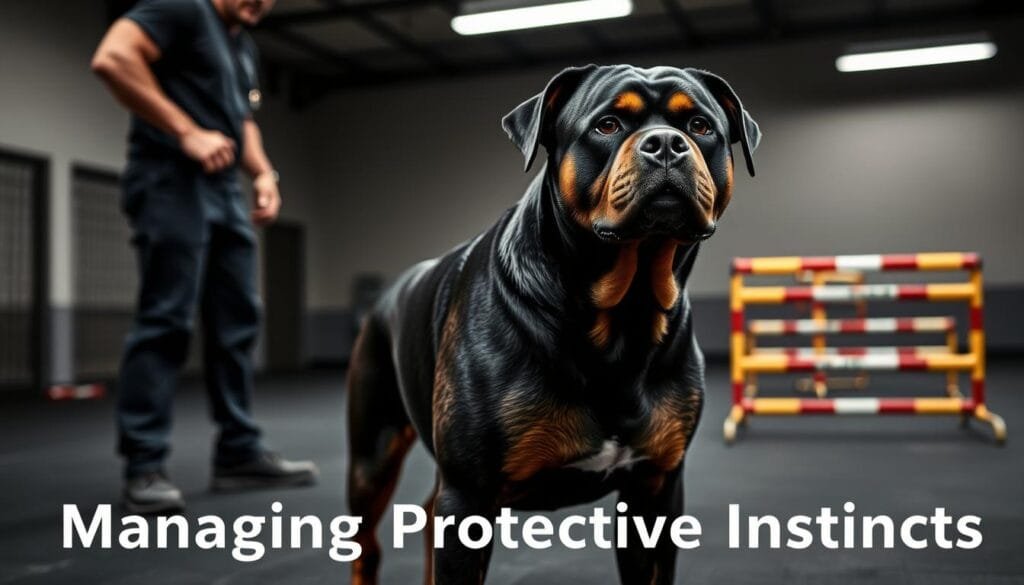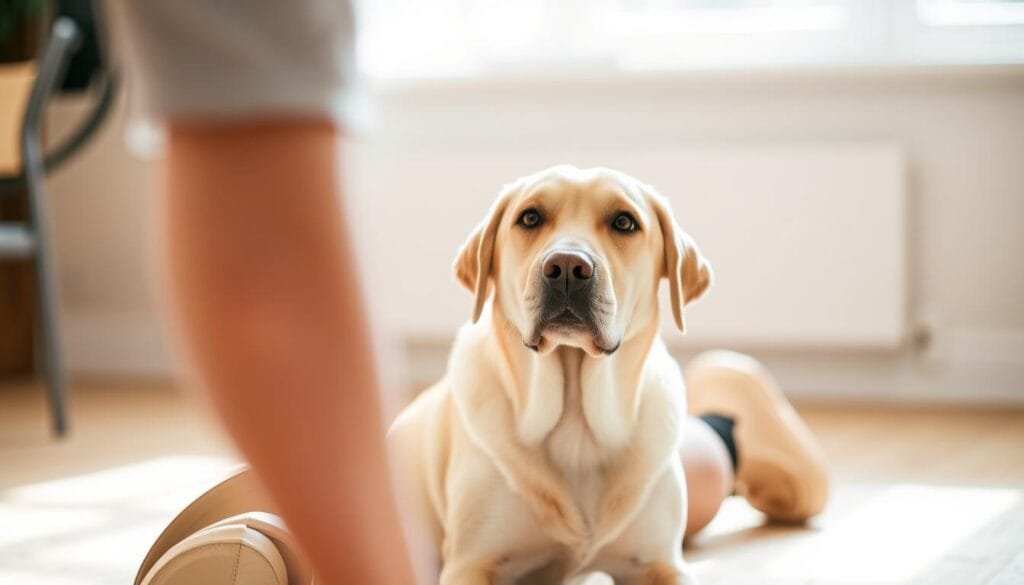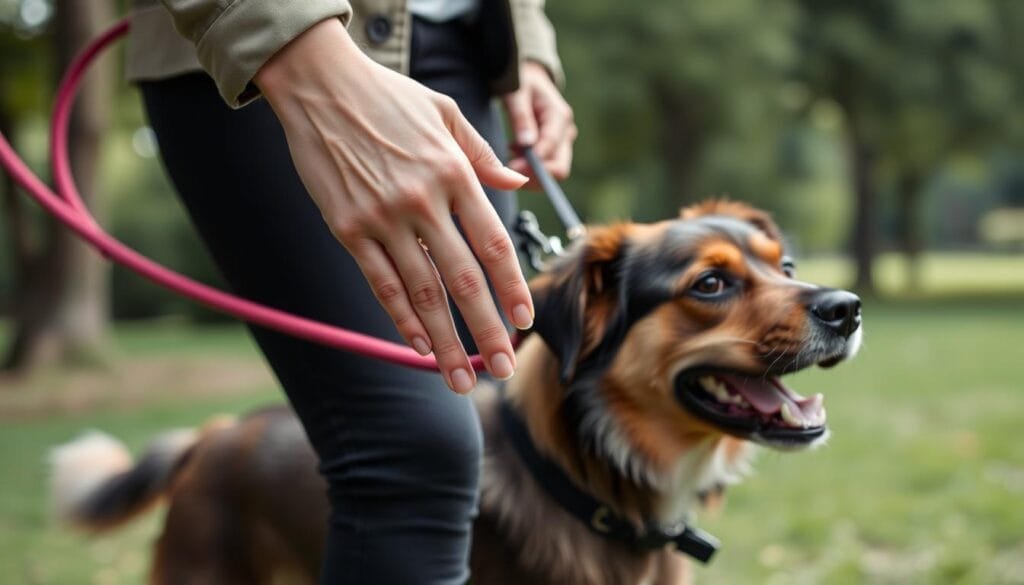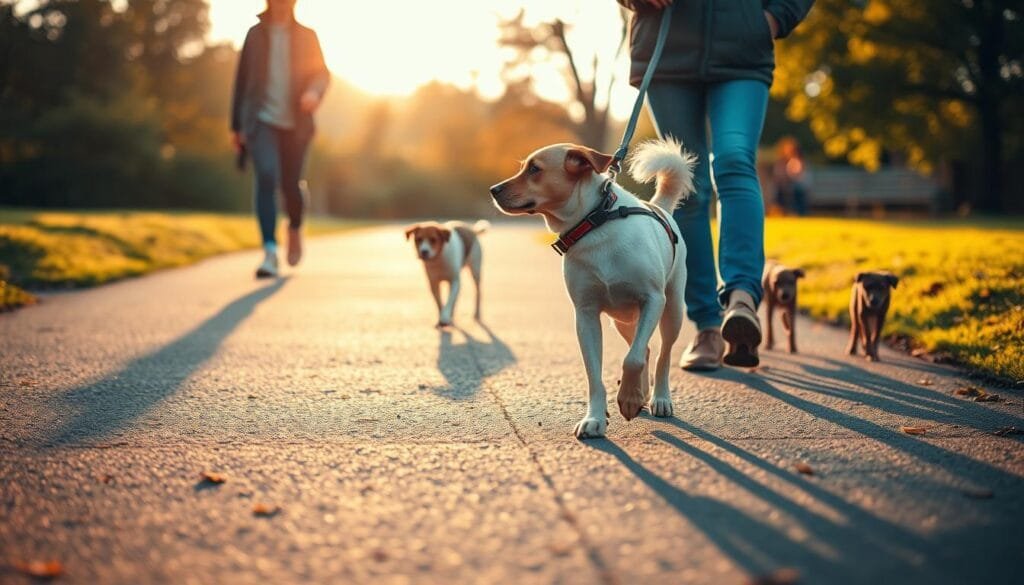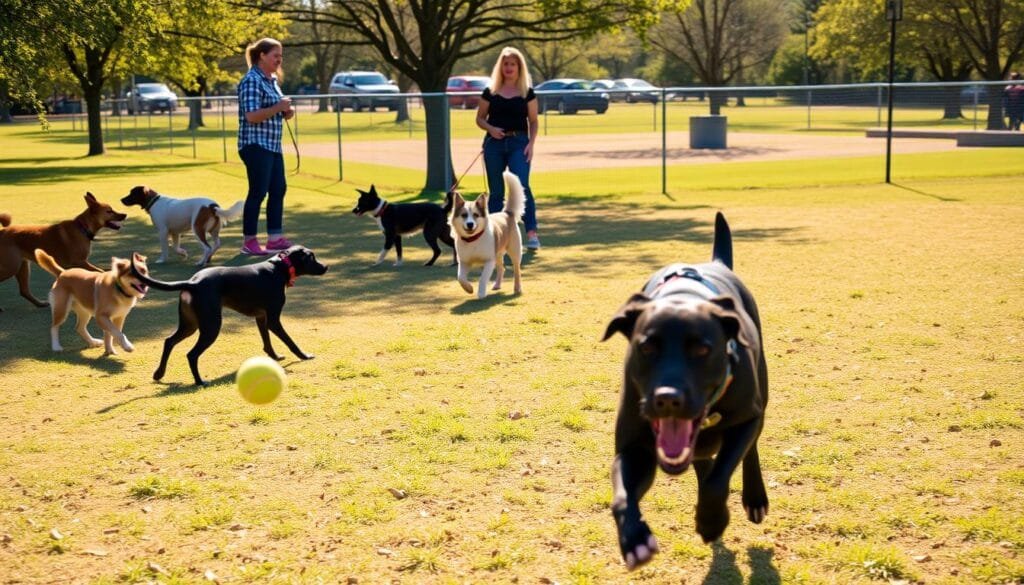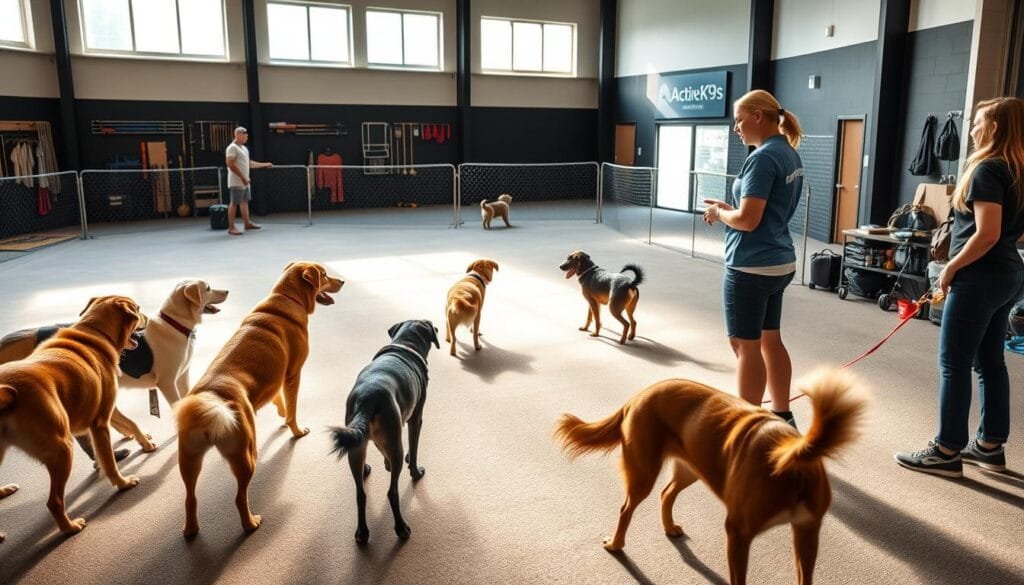Master Golden Retriever Training: Essential Steps for Success
Did you know that golden retrievers can learn up to 165 different words and commands? This makes them one of the most intelligent dog breeds globally. Our comprehensive guide will help unlock your furry friend’s incredible potential. It will also strengthen your bond with them.
Training a golden retriever demands patience, consistency, and a deep understanding of their temperament. These dogs are not mere pets; they are intelligent companions eager to learn and please. Puppy training is crucial, laying the groundwork for a lifetime of harmony and mutual respect.
As professional dog trainers, we know the nuanced approach required for effective golden retriever training. Each session is a chance to deepen your bond and enhance your dog’s cognitive abilities.
Key Takeaways:
- Start training early to maximise learning potential
- Use positive reinforcement techniques
- Keep training sessions short and engaging
- Maintain consistency across all family members
- Understand your golden retriever’s unique learning style
Understanding Golden Retriever Temperament and Behaviour
Golden Retrievers are renowned for their intelligence and sociable nature, making them cherished family pets. Their exceptional dog behaviour renders them perfect for households in search of a loyal and trainable companion.
Grasping the distinct traits of Golden Retrievers is vital for successful positive reinforcement training. These dogs, ranking third in popularity in the United States, exhibit a friendly temperament in 60% of cases.
Natural Intelligence and Learning Capacity
Golden Retrievers excel in learning, ranking fourth in working and obedience intelligence. Studies reveal that:
- 70% are highly trainable
- 50% display a strong desire to please their owners
- They typically learn new commands in 5-15 repetitions
Social Nature and Family Orientation
Golden Retrievers are ideal for families due to their exceptional social skills. Approximately 80% of owners report their dogs as affectionate and loyal companions. They also show remarkable adaptability to new environments, with 75% adapting well.
Energy Levels and Exercise Requirements
Golden Retrievers are high-energy dogs, necessitating considerable physical activity. Key insights on exercise include:
- Minimum 1 hour of daily exercise
- 40-60 minutes of hard physical activity recommended
- Outdoor activities like fetch and swimming are ideal
Training success with Golden Retrievers relies on understanding their unique personality and meeting their physical and mental stimulation needs.
Essential Equipment for Training Success
Effective obedience training hinges on the selection of appropriate tools. For Golden Retrievers, the right equipment can elevate your reward-based training sessions from daunting to delightful.
Let’s examine the crucial gear every Golden Retriever owner must have:
- Training Collar: A well-fitted martingale collar offers control without causing discomfort
- Training Leash: A 4-6 foot flat leash is perfect for close-contact training
- Treat Pouch: Ensures rewards are readily available during training
- Clicker: A precise marker for positive reinforcement techniques
When choosing training equipment, focus on quality and comfort. Bumpers are essential for retriever training, with white bumpers being the most visible. Professional trainers advise buying in bulk to save up to 30% on costs.
Additional tools worth considering include:
- Training whistle (£5-£30)
- Electronic training collar
- Long check cord (20-30 feet)
- Interactive training toys
Investing in the correct equipment is crucial for effective obedience training. Your Golden Retriever will benefit from a consistent, positive learning environment. This makes training both enjoyable and rewarding.
Starting with Basic Golden Retriever Training
Embarking on puppy training with your Golden Retriever is an exciting journey. It requires patience, consistency, and understanding. The first few weeks are crucial in establishing a strong foundation for obedience training. They also help in building a lasting bond with your furry companion.
https://www.youtube.com/watch?v=Kr5ZF7iwPTo
Golden Retrievers are exceptionally intelligent dogs that respond brilliantly to early training. Research suggests the optimal window for introducing training begins immediately after bringing your puppy home. Initial sessions are recommended around 7 weeks old.
House Training Fundamentals
Successful house training relies on a structured approach. Here are key strategies for effective potty training:
- Take your puppy outside every 2-3 hours
- Choose a consistent outdoor elimination spot
- Reward immediate success with treats and praise
- Maintain a regular feeding schedule
Crate Training Basics
Crate training provides a safe space for your puppy and aids in house training. The process should be gentle and positive. Make the crate a comfortable environment. Aim for short, positive experiences that help your puppy view the crate as a secure den.
Leash Training Introduction
Introducing leash training requires patience and consistency. Start with short sessions, using positive reinforcement techniques. Golden Retrievers typically respond well to treats and praise during obedience training. This makes leash learning an enjoyable experience.
Remember, most puppies require approximately 15-25 minutes of daily exercise. Training sessions should last 2-5 minutes. Consistency is key in developing well-behaved, confident Golden Retrievers.
The Power of Positive Reinforcement
Positive reinforcement training is a transformative method for Golden Retriever owners aiming to forge a robust, trusting bond with their pets. Studies indicate that this approach can elevate desired actions by as much as 75%, marking it as a highly potent strategy.
Golden Retrievers flourish in environments rich with positive interactions, their intelligence making them highly receptive to reward-based training. By concentrating on acknowledging and rewarding commendable actions, you establish a motivational learning space. This environment not only fortifies your connection but also expedites the acquisition of new skills.
- Reduces fear and anxiety-related behaviours by 60%
- Improves training efficiency by up to 50%
- Helps dogs learn commands 30% faster
- Builds confidence and trust
The essence of successful positive reinforcement training hinges on consistency and timing. Upon your Golden Retriever exhibiting a desired action, promptly reward them with a treat, commendation, or cherished toy. This immediate reward clarifies which behaviour is being lauded.
Training should be a joyful experience for both dog and owner, creating a positive learning atmosphere that encourages growth and understanding.
Adopting these strategies will not only impart essential skills but also deepen your bond with your Golden Retriever. This method transforms the training process from a potential challenge into a delightful, enriching journey of mutual respect and dialogue.
Socialisation Techniques and Timing
Puppy training is a pivotal journey, starting with effective socialisation. Golden Retrievers, being naturally social, benefit from structured exposure to diverse environments. This shapes their behaviour and boosts confidence.
The critical socialisation window for puppies spans from 3 to 16 weeks, with the most pivotal period up to 14 weeks. During this time, your golden retriever puppy is most open to new experiences.
Early Exposure to Different Environments
Introducing your puppy to various settings is crucial for their development. Essential strategies include:
- Visit parks with controlled environments
- Expose your puppy to different surfaces (grass, concrete, wood)
- Introduce diverse sounds and movements gradually
- Create positive associations with new experiences
Meeting Other Dogs Safely
Safe interactions with other dogs are vital in puppy training. Studies indicate that 49% of puppies attend training classes, enhancing their social skills.
“Proper socialisation prevents negative behaviours and builds a trusting relationship between dogs and owners.”
Building Confidence in Public Spaces
Building your golden retriever’s confidence requires patience and strategic exposure. Begin with short, positive experiences in calm public areas. Gradually increase complexity and duration.
By adhering to these socialisation techniques, you’ll cultivate a well-adjusted, confident companion. They will be ready to handle various social situations.
Common Training Challenges and Solutions
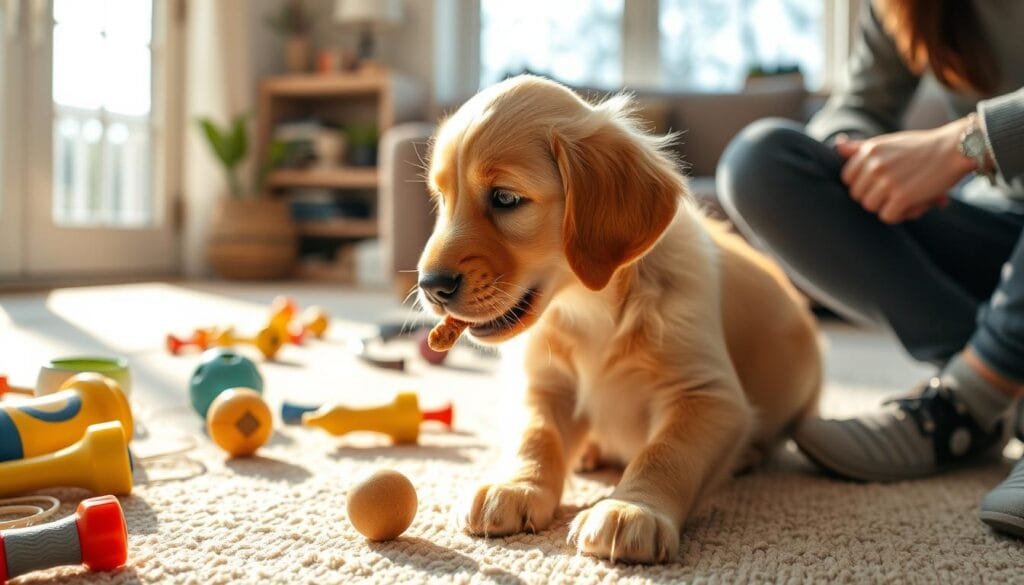
Golden retrievers are cherished for their amiable disposition, yet their behaviour can pose distinct training hurdles. These intelligent canines often excel in obedience, yet they may occasionally exhibit a stubbornness that tests the endurance of their owners.
Grasping the common training obstacles is vital for effective dog behaviour management. Our research uncovers some enlightening facts:
- Most dogs are undertrained, indicating a widespread training challenge
- Training opportunities can occur in brief two-minute windows throughout the day
- Consistent training from puppyhood is essential for developing good behaviour
Obedience training necessitates a strategic approach. Quick, consistent training sessions can markedly enhance your golden retriever’s responsiveness. Implement these practical strategies:
- Practice short commands during daily activities
- Use reward-based training techniques
- Ensure all family members use consistent commands
| Training Challenge | Potential Solution |
|---|---|
| Stubborn behaviour | Positive reinforcement and patience |
| Distraction during training | Gradual exposure and focused sessions |
| Energy management | Regular exercise and mental stimulation |
Every golden retriever is distinct. Tailor your obedience training to your dog’s unique personality and learning style. With persistence and understanding, you can triumph over most training hurdles.
Advanced Obedience Commands
Advancing your Golden Retriever’s obedience training necessitates patience, consistency, and the development of strategic skills. This progression transforms your dog into a responsive, intelligent companion, capable of complex interactions. It elevates them from a basic command learner to a sophisticated partner.
Experts suggest mastering around 10 essential commands in advanced obedience training. These commands transcend basic instructions, establishing a sophisticated communication system between you and your pet.
Stay and Recall Training
Mastering the stay and recall commands is vital for ensuring off-leash training safety. Key strategies include:
- Begin with short, controlled distances
- Use consistent verbal and hand signals
- Gradually increase distraction levels
- Reward immediate responses
Off-Leash Control Techniques
Off-leash training demands exceptional trust and communication. Our recommended approach involves gradual progression and positive reinforcement. Begin in enclosed spaces, employing obedience training principles to foster confidence.
Hand Signal Commands
Silent communication is incredibly powerful in off-leash training. Dogs are naturally attuned to visual cues, making hand signals an excellent advanced training tool. Practice signals such as:
- Sit
- Down
- Stay
- Come
- Heel
Remember, advanced training is about quality, not quantity. Patience and consistency are your greatest allies.
Managing Excessive Excitement and Jumping
Golden retrievers are renowned for their exuberant nature, often manifesting in overzealous greetings. Grasping the intricacies of dog behaviour is essential for managing their natural exuberance. This understanding fosters positive interactions.
Jumping is a prevalent issue for many dog owners. When golden retrievers become excessively excited, they frequently display their joy by jumping towards individuals. This behaviour can be overwhelming and poses potential dangers.
- Recognise the root causes of excessive excitement
- Implement consistent positive reinforcement training
- Redirect energy into controlled behaviours
Positive reinforcement training emerges as a potent strategy for addressing jumping issues. The objective is to teach alternative greeting methods that are both calm and controlled. By rewarding your dog for remaining on all fours, you can gradually mould their social interaction approach.
| Behaviour | Training Strategy | Expected Outcome |
|---|---|---|
| Jumping | Ignore and redirect | Calm greetings |
| Excessive excitement | Controlled socialisation | Improved emotional control |
Training methodologies necessitate consistent practice and patience. Nearly one million dog owners have successfully navigated similar hurdles through structured methods that concentrate on rewarding desired actions.
The ultimate aim is to cultivate a well-behaved companion who can engage confidently and calmly in diverse social settings. By dedicating time to positive reinforcement training, you will fortify your bond with your golden retriever.
Lead Walking and Proper Etiquette
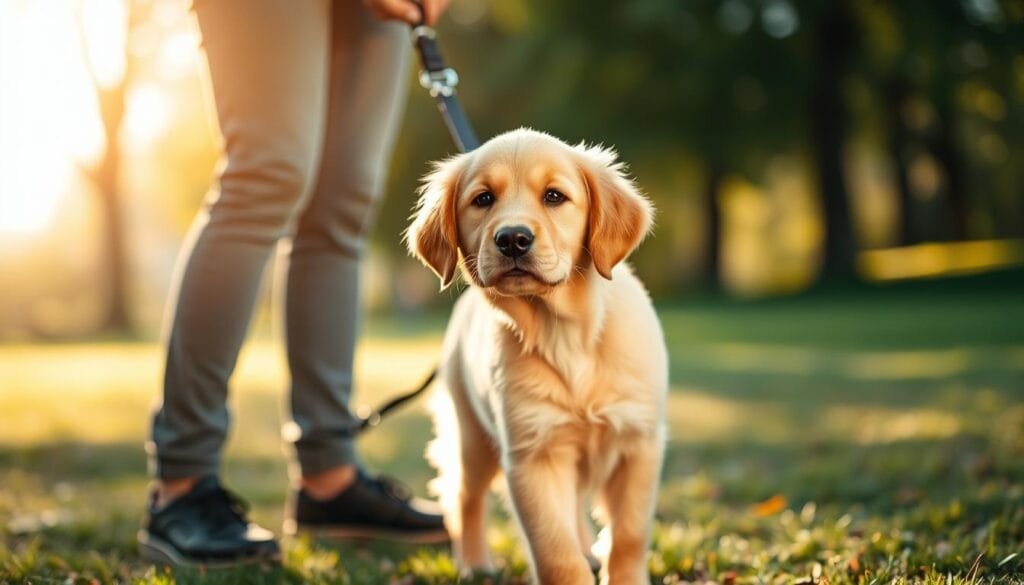
Mastering lead walking is a critical aspect of obedience training for Golden Retrievers. With 60% of puppies exhibiting pulling behaviour when first introduced to leash walking, it’s essential to develop effective training techniques.
Puppy training requires patience and a consistent approach. Research shows that 90% of trainers recommend using treats as a reinforcement tool during leash training to encourage good behaviour. Here are key strategies to improve lead walking:
- Start training in low-distraction environments
- Use short, frequent training sessions (5-10 minutes)
- Reward calm walking with high-value treats
- Stop moving when your dog pulls
- Change direction to redirect attention
Professional trainers emphasise that 75% of dogs show significant improvement in walking behaviour within the first few weeks of consistent training.
“The key to successful leash walking is understanding that dogs learn pulling works if they are allowed to move forward even once while pulling.” – Professional Dog Training Expert
In Ireland, responsible dog ownership means adhering to local regulations. While no specific breed is banned, certain dogs must follow strict leash and public behaviour guidelines. Always ensure your Golden Retriever is under control and walks politely beside you.
Remember, 100% consistency is crucial in teaching your dog to walk calmly on a lead. With dedicated obedience training and positive reinforcement, you’ll transform challenging walks into enjoyable bonding experiences.
Age-Specific Training Guidelines
Training a Golden Retriever necessitates a nuanced approach, tailored to their developmental stages. It is essential to comprehend how puppy training and dog behaviour evolve throughout their life. This understanding is crucial for forging a strong, enduring bond.
The journey of dog training commences with the recognition of each life stage’s unique characteristics. Dr. Carmen Battaglia’s “Rule of 7” posits that puppies should experience approximately 49 different experiences by 12 weeks of age. This is vital for their healthy development.
Puppy Development Stages
Early puppyhood is a pivotal period for socialisation and learning. Research indicates that 90% of a dog’s social skills are developed within the first 16 weeks. During this time, it is imperative to conduct short training sessions:
- Conduct 3-4 training sessions daily
- Keep each session to 5 minutes
- Focus on positive reinforcement
Adult Dog Training Adjustments
As Golden Retrievers mature, their training needs evolve. Studies reveal that 60% of behavioural issues in adult dogs can be addressed through targeted training programs. This stage focuses on refining existing skills, introducing complex commands, and maintaining consistent obedience.
- Refining existing skills
- Introducing complex commands
- Maintaining consistent obedience
Senior Dog Considerations
In their golden years, mental stimulation becomes paramount. Research suggests that puzzle toys and continued training can reduce cognitive decline by up to 30%. Adaptations include:
| Age Range | Training Focus | Key Considerations |
|---|---|---|
| 7-10 Years | Low-impact mental exercises | Shorter, gentler sessions |
| 10+ Years | Cognitive maintenance | Adaptive training techniques |
Remember, lifelong learning keeps your Golden Retriever mentally sharp and strengthens your bond.
Training is not about perfect obedience, but about building a relationship of trust and understanding.
Building Self-Control and Patience
Training your golden retriever’s self-control is a critical aspect of dog behaviour and obedience training. Dogs lack natural impulse control, necessitating the teaching of emotional management. This is crucial for them to handle their excitement and emotions effectively.
Research shows that nearly every behaviour problem in dogs stems from a lack of impulse control. Golden retrievers, with their high energy, greatly benefit from structured training. This helps them develop patience and restraint.
“Self-control is not about suppressing emotions, but about managing them intelligently.” – Professional Dog Trainer
Key strategies for developing self-control include:
- Implementing wait and leave it commands
- Practicing calm behaviours during exciting situations
- Gradually increasing training difficulty
- Reinforcing polite behaviour with rewards
Specific training exercises can dramatically improve your dog’s impulse control. For instance, teaching your golden retriever to:
- Wait calmly before eating
- Remain settled when guests arrive
- Stay quiet during playtime
- Pause before crossing thresholds
Consistent training transforms impulse control from a challenging skill to a natural behaviour. By dedicating time to these techniques, you’ll create a more composed and manageable companion. They will understand boundaries and self-regulation.
Golden Retriever Training: Professional Tips and Techniques

Professional golden retriever training necessitates a methodical strategy, blending expertise, patience, and comprehension. Given that 80% of dog trainers endorse positive reinforcement, we will dissect advanced methods to enhance your obedience training proficiency.
Clicker training emerges as a premier approach for golden retriever training. This method employs a small device that emits a distinct sound, marking exact instances of desired actions. Studies affirm that dogs trained through positive reinforcement exhibit a 70% higher likelihood of retaining learned behaviours.
- Use high-value treats as rewards
- Keep training sessions short and engaging
- Maintain consistent command language
- Practice immediate reward techniques
Grasping your golden retriever’s body language is paramount. Subtle signals can indicate readiness to learn or potential stress. Professional trainers advocate observing your dog’s ear position, tail movement, and overall posture during training sessions.
| Training Technique | Effectiveness Rating | Key Benefits |
|---|---|---|
| Clicker Training | 85% | Precise behaviour marking |
| Positive Reinforcement | 90% | Builds strong dog-owner bond |
| Consistent Command Training | 75% | Reduces dog confusion |
In the face of training challenges, professional advice is invaluable. Seek assistance from certified dog trainers who specialise in golden retriever training if persistent behavioural issues persist.
Remember, every golden retriever is unique. Patience and personalised approach are key to successful training.
Preventing and Addressing Behavioural Issues
Understanding dog behaviour is paramount for a harmonious relationship with your golden retriever. These dogs, known for their friendly disposition, can still develop challenging behaviours. Such issues necessitate careful management and positive reinforcement training.
Golden retrievers may face various behavioural challenges that require immediate attention. Studies indicate that up to 50% of dog owners encounter behavioural issues with their pets at some stage.
- Jumping on people
- Excessive barking
- Resource guarding
- Lead pulling
- Anxiety-related behaviours
Identifying the root causes of these behaviours is crucial. Genetics, environment, and socialization significantly influence a dog’s temperament. Positive reinforcement training can effectively redirect unwanted behaviours.
Early intervention is key to managing behavioural challenges in golden retrievers.
We advocate for a comprehensive approach to addressing dog behaviour:
- Conduct regular training sessions
- Provide mental and physical stimulation
- Use consistent training techniques
- Seek professional guidance when needed
| Behaviour Issue | Potential Cause | Training Strategy |
|---|---|---|
| Excessive Barking | Anxiety or Boredom | Mental Stimulation and Quiet Command |
| Jumping | Excitement | Consistent Positive Reinforcement |
| Lead Pulling | Lack of Training | Structured Walking Techniques |
Professional dog behaviourists from organizations like the Animal Behaviour and Training Council offer specialised support for complex behavioural challenges. Remember, each golden retriever is unique, and tailored approaches yield the best results.
Mental Stimulation and Training Games
Golden Retrievers, renowned for their intelligence, flourish on mental challenges. Experts in dog behaviour underscore the importance of mental stimulation for their happiness and engagement. Reward-based training is an effective method to stimulate their minds while fortifying your relationship.
Interactive games can elevate routine training into stimulating brain exercises. Engaging activities such as puzzle toys, scent work, hide and seek, and rotating toys are essential to maintain their mental acuity.
- Puzzle toys that challenge problem-solving skills
- Scent work exercises tapping into natural hunting instincts
- Hide and seek games that utilise their superior sense of smell
- Rotating toy collections to maintain interest
Studies indicate that 5-15 minutes of mental exercise daily can exhaust your dog. Interactive toys enhance listening and problem-solving skills. Eye contact during these activities stimulates oxytocin release, deepening your emotional bond.
Preventing boredom-related behaviours is paramount. Dogs displaying destructive actions like excessive chewing or tail-chasing require more mental stimulation. Agility training, new walking routes, and teaching tricks can significantly reduce hyperactivity and boost cognitive function.
Mental exercise is as important as physical exercise for your Golden Retriever’s overall wellbeing.
Incorporating these mental stimulation techniques will result in a happier, more focused companion. They will relish learning and the time spent with you.
Conclusion
Golden retriever training is a transformative experience that builds an unbreakable bond between you and your furry companion. By investing time and patience in developing your dog’s skills, you create a foundation for a harmonious relationship. This extends far beyond basic obedience.
Whether you’re preparing for service dog training or simply aiming to have a well-behaved family pet, the key is consistent positive reinforcement. Golden retrievers are remarkable learners, renowned for their intelligence and eagerness to please. Their adaptable nature makes them excellent candidates for advanced training techniques that challenge and engage their remarkable cognitive abilities.
Professional trainers recommend viewing training as an ongoing dialogue with your dog. Each session is an opportunity to strengthen communication, build trust, and help your golden retriever develop confidence in various environments. Remember that every dog learns differently, so flexibility and understanding are crucial in creating a successful training experience.
With dedication, love, and the right approach, you’ll transform your golden retriever into a well-adjusted, responsive companion. This companion will bring joy and companionship to your life. The journey of training is as rewarding for you as it is for your four-legged friend.
FAQ
At what age should I start training my golden retriever puppy?
Training can commence as early as 8 weeks for your golden retriever puppy. Begin with foundational commands and socialisation, employing positive reinforcement. This period is critical for learning, necessitating consistent and gentle training to establish a robust foundation.
How long does it typically take to house train a golden retriever?
House training typically takes 4-6 months for golden retrievers, though some may require up to a year. Consistency, positive reinforcement, and a regular routine are paramount. Patience is crucial, as each puppy learns at their own pace. Crate training and regular potty breaks can expedite the process.
Are golden retrievers easy to train compared to other dog breeds?
Golden retrievers are renowned for their ease of training, attributed to their intelligence, eagerness to please, and natural inclination to work with humans. Their quick learning and desire to please make them ideal for both basic and advanced training. Consistent, positive reinforcement and mental stimulation are essential.
How much daily training time do golden retrievers need?
Allocate 10-15 minutes for training sessions, conducted 2-3 times daily. Given their high energy and short attention span, training should be brief and engaging. As they mature, sessions can be lengthened and made more complex.
What are the most important basic commands to teach a golden retriever?
Essential commands include sit, stay, come, down, and heel. These commands are vital for your dog’s safety and basic control. Teaching leave it and wait commands can also be beneficial in managing their curiosity and enthusiasm.
How do I stop my golden retriever from jumping on people?
To prevent jumping, teach an alternative greeting behaviour, such as sitting. Use consistent positive reinforcement by ignoring jumping and rewarding calm greetings. Ensure all family members and visitors adhere to this approach, reinforcing good behaviour with treats and praise.
Can older golden retrievers still be trained?
Yes, older golden retrievers can still be trained. While they may learn more slowly, patience and positive reinforcement are key. Adapt training to any physical limitations and provide mental stimulation to keep them engaged and potentially slow cognitive decline.
How do I prevent my golden retriever from pulling on the lead?
Employ reward-based training, such as the ‘stop and wait’ method, to prevent pulling. When your dog pulls, stop walking and wait until the lead is slack before proceeding. Consider using a front-clip harness to discourage pulling. Reward loose-lead walking with treats and praise to reinforce the desired behaviour.
Source Links
- 10 Tips for Training Your Golden Retriever – https://be.chewy.com/10-tips-for-training-your-golden-retriever/
- 10 Tips for Training Golden Retriever: Adult & Puppies – https://www.dogseechew.in/blog/10-tips-for-training-golden-retriever-adult-puppies
- Golden Retriever: Temperament, Lifespan, Grooming, Training – https://www.petplan.co.uk/pet-information/dog/breed/golden-retriever/
- The Vet’s Guide to Golden Retrievers: Facts, Care, and Training Tips | Vets Love Pets – https://vetslovepets.com.au/blogs/dog/golden-retriever-breed-guide?srsltid=AfmBOooegHddVqVerMGP2HXuKFlNnUmNxCPPFJaP6p-9feL9xyByRmm5
- Temperaments of a Golden Retriever – https://www.barkingmad.uk.com/blog/dog-ownership/temperaments-of-a-golden-retriever/
- Basic Retriever Training Equipment (Glenda Brown) – Golden Retriever Club of America – https://grca.org/events/field-events-field-training/field-training-articles/basic-retriever-training-equipment-glenda-brown/
- 6 vital tools every gun dog owner needs – https://ottertailkennels.com/vital-tools-retriever-training/
- Retriever Training from Day One – Gun Dog – https://www.gundogmag.com/editorial/retriever-training-day-one/374503
- Effective Golden Retriever Training: 10 Proven Strategies – https://citizenshipper.com/blog/effective-golden-retriever-training/
- How to Train a Golden Retriever Puppy | Complete Training Guide – https://zigzag.dog/blog/puppy-training/breed-specific/guide-how-to-train-golden-retriever-puppy/
- The Power of Positivity: A Comprehensive Guide to Training Your Dog with Positive Reinforcement | Kabo – https://kabo.co/blog/the-power-of-positivity-a-comprehensive-guide-to-training-your-dog-with-positive-reinforcement
- The Power of Positive Reinforcement Training: Transforming Lives One Paw at a Time. — Van Hendrix K-9 Training – https://www.vhk9.net/blog/the-power-of-positive-reinforcement-training-transforming-lives-one-paw-at-a-time/13/11/2024
- No title found – https://www.akc.org/expert-advice/dog-breeds/golden-retriever-puppy-training-timeline/
- Puppy Socialization Training Guide | Golden Meadows – https://goldenmeadowsretrievers.com/puppy-socialization-training-guide/
- Overlooked Training Opportunities for Retrievers – Gun Dog – https://www.gundogmag.com/editorial/overlooked-training-opportunities-retrievers/331815
- Golden Retriever – https://www.pdsa.org.uk/pet-help-and-advice/looking-after-your-pet/puppies-dogs/large-dogs/golden-retriever
- My List of Commands – https://www.obedienceroad.com/blog/my-list-of-commands
- Advanced dog obedience commands – Dog Training Tips – https://dogtrainingtips.ie/advanced-dog-obedience-commands/
- Six Essential Commands for Retrievers | Ducks Unlimited – https://www.ducks.org/hunting/retriever-training/six-essential-commands-for-retrievers
- From chaos to calm: How to manage an overly excited dog – https://spca.bc.ca/news/calming-overly-excited-dog-tips-tricks/
- No title found – https://www.akc.org/expert-advice/training/stop-dog-jumping/
- No title found – https://www.akc.org/expert-advice/training/teach-puppy-walk-leash/
- How to stop your dog pulling on the lead | Dogs Trust – https://www.dogstrust.ie/dog-advice/training/outdoors/walking-nicely-training
- The Ultimate Guide to Golden Retriever Training | GMR – https://goldenmeadowsretrievers.com/the-ultimate-golden-retriever-training-guide/
- Golden Retriever Training | How to Train Your Dog – https://www.sniffspot.com/blog/dog-training/how-to-train-your-golden-retriever
- What Are the Best Ages for Dog Training (and Why) | Onalaska Animal Hospital – https://www.onalaskaanimalhospital.com/blog/what-are-the-best-ages-for-dog-training-and-why
- No title found – https://www.akc.org/expert-advice/training/teaching-your-dog-self-control/
- Teaching a Dog Impulse Control – Paws and Possibilities – https://pawsandpossibilities.com/teaching-dog-impulse-control/
- Positive Reinforcement Training — Golden Retriever Life – https://www.goldenretrieverlife.com/blog/positive-reinforcement-training
- Award-Winning Golden Retriever Training On-Demand – https://www.goodasgolden.co.uk/academy
- The Simple, Can’t-Miss Guide on Training A Golden Retriever – https://pogis.com/blogs/news/the-simple-can-t-miss-guide-on-training-a-golden-retriever?srsltid=AfmBOoq-aBzyXqllp6Fe6ps9DdVT2SnA62Nwncbpe61x7gdi0WJz8JcG
- Training Golden Retrievers – A Realistic, Honest Golden Retriever Training Guide — Best Mate Dog Training | Online Dog Training Without Treats – https://www.bestmatedogtraining.co.nz/golden-retriever-dog-training-guide
- No title found – https://www.akc.org/expert-advice/training/how-to-curb-unwanted-dog-behaviors/
- Finding behaviour and training support | Dogs Trust – https://www.dogstrust.org.uk/dog-advice/understanding-your-dog/finding-behaviour-and-training-support
- No title found – https://www.akc.org/expert-advice/training/fun-cognitive-training-games-for-dogs/
- 9 Cost-Effective Ways To Keep Your Dog Mentally Stimulated – https://www.petmd.com/dog/general-health/ways-to-keep-dog-mentally-stimulated
- The Positive Impact of Obedience Training on Golden Retrievers – https://www.mygoldenretrieverpuppies.com/blog/golden-retriever-obedience-training
- How to Train a Golden Retriever: Expert Tips & Tricks – Dogster – https://www.dogster.com/dog-training/how-to-train-a-golden-retriever
- Golden Retrievers: The Ultimate Guide for This Loyal Breed – https://www.bonza.dog/2024/10/golden-retrievers-the-ultimate-guide-for-this-loyal-breed/?srsltid=AfmBOorZM69APtY1LQ6YZ5ComUzfBllGWfgFpu01fh52PpSPNCOWIdOp

